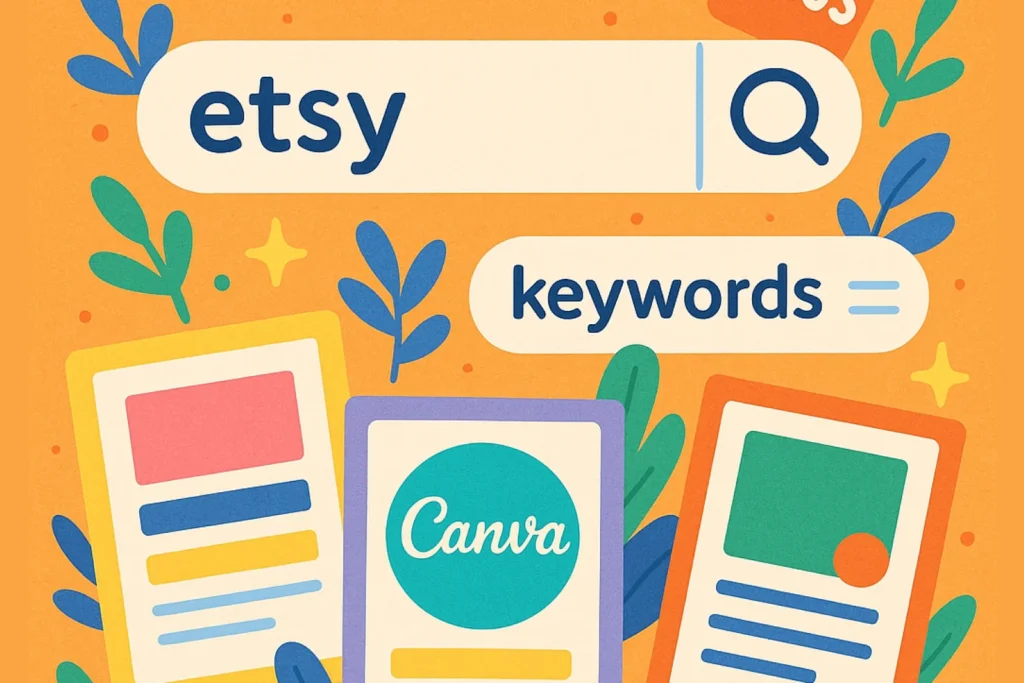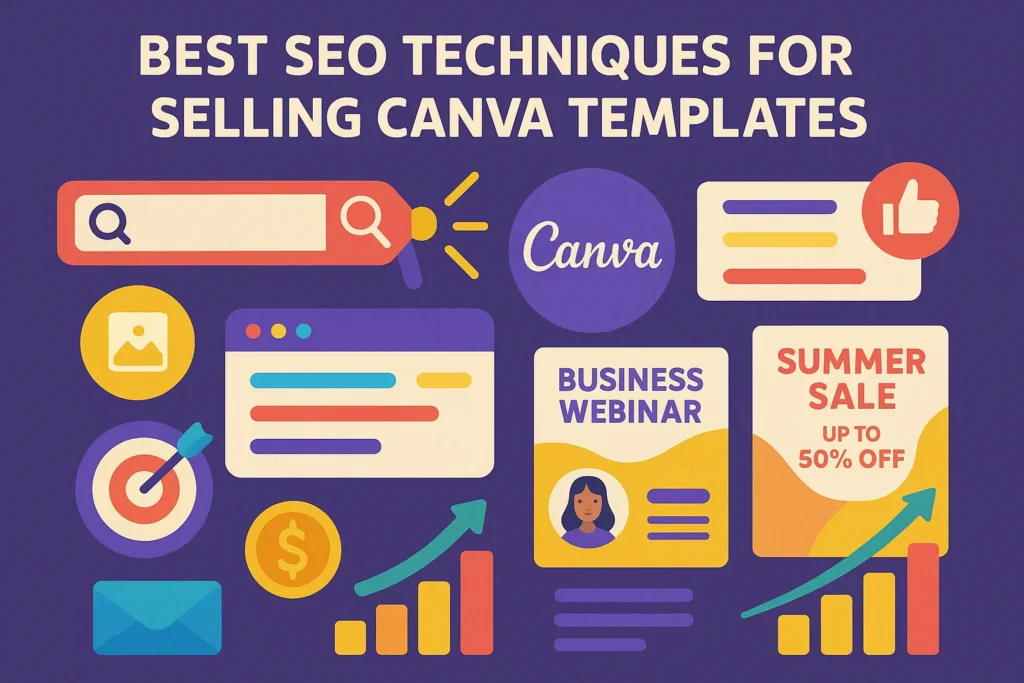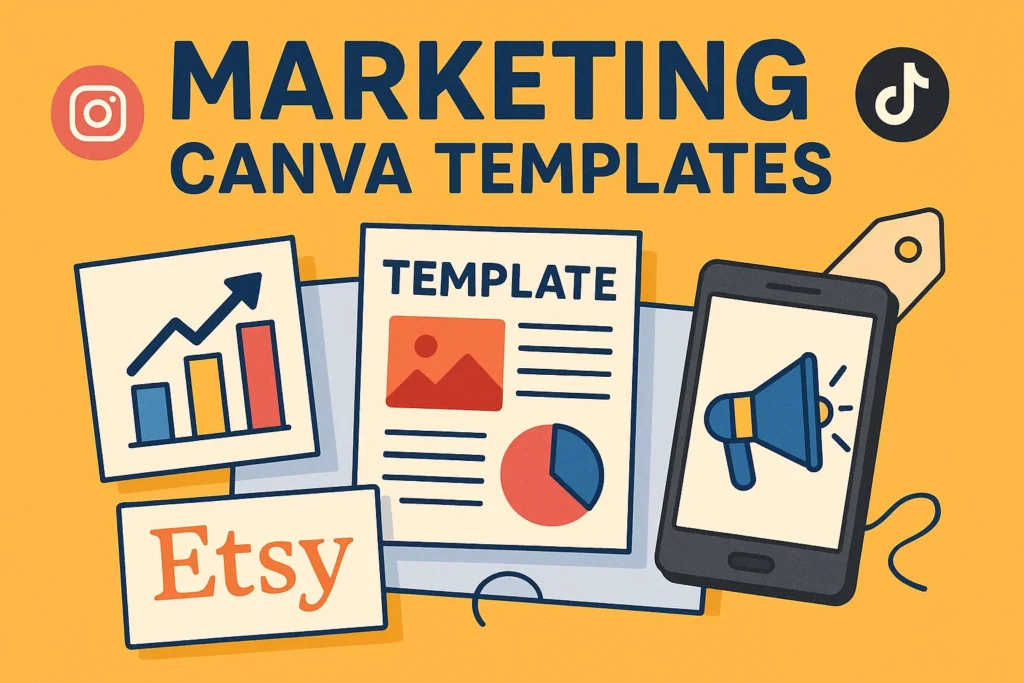Here’s something most people don’t realize: some of the most successful online entrepreneurs never show their faces, never record videos, and never deal with customer service calls. They’ve built six-figure businesses selling something incredibly simple—Canva templates. While others struggle with complicated business models, these smart entrepreneurs discovered that when you start Canva template business for beginners, you’re tapping into a market that’s hungry for solutions and willing to pay premium prices for quality designs.
Key Takeaways
Starting a Canva template business is one of the most accessible ways for beginners to enter the digital product space and generate passive income. Here’s what you need to know:
- Choose your niche first – Target specific audiences like small business owners, social media managers, or bloggers rather than creating generic templates
- Start with 12-15 high-quality templates – Build a solid foundation before expanding your product line
- Master the template creation process – Design in Canva, create shareable links, and package everything in professional PDFs
- Price strategically – Research competitor pricing and start competitively while building your reputation
- Sell on multiple platforms – Use Etsy, your own website, and other marketplaces to maximize reach
- Focus on marketing – Leverage social media, SEO, and email marketing to drive consistent sales
- Understand licensing – Know the difference between personal use, commercial use, and PLR/MRR templates
Understanding The Canva Template Business Model
The beauty of the Canva template business lies in its simplicity and scalability. When you create a template, you’re essentially building a digital asset that can be sold repeatedly without additional production costs. This creates what entrepreneurs call “passive income”—money that continues flowing even when you’re not actively working.
Canva templates serve a massive market of time-strapped business owners, content creators, and marketers who need professional designs but lack the skills or time to create them from scratch. They’re willing to pay for ready-made solutions that they can quickly customize with their own branding and content.
The business model works because you’re solving a real problem: the gap between needing professional-looking designs and having the expertise to create them. Small business owners might spend hours struggling with design software, while your templates let them achieve professional results in minutes.
What Makes This Business Beginner-Friendly
Unlike many online businesses that require significant upfront investment or technical skills, starting a Canva template business has virtually no barriers to entry. You need a free Canva account, creativity, and the willingness to learn what your target market wants.
The learning curve is gentle because Canva’s interface is designed for non-designers. You don’t need to master complex software like Photoshop or Illustrator. Everything you need is available through Canva’s drag-and-drop editor.
Most importantly, you can start small and scale gradually. Begin with a few templates in one niche, test the market response, then expand based on what sells best. This approach minimizes risk while maximizing learning opportunities.
Choosing Your Profitable Niche
Success in the template business starts with smart niche selection. Generic templates face massive competition, while niche-specific designs can command premium prices and build loyal customer bases.
Research-Driven Niche Selection
Start by exploring what’s already selling well. Visit Etsy and search for “Canva templates” to see which categories have the most listings and sales. Look for niches with decent demand but not overwhelming competition.
Consider these high-demand niches:
- Real estate professionals need listing flyers, social media posts, and client presentations
- Health and wellness coaches require workout planners, meal prep guides, and motivational graphics
- Small business owners want social media templates, price lists, and marketing materials
- Content creators need YouTube thumbnails, Instagram story templates, and blog graphics
- Event planners require invitation suites, planning checklists, and promotional materials
The key is finding the sweet spot between demand and competition. A niche with 1,000 template listings might seem crowded, but if those listings are getting consistent sales, there’s clearly strong demand.
Understanding Your Target Customer
Once you’ve identified a potential niche, dig deeper into understanding your ideal customer. What specific problems do they face? What design styles appeal to them? How much are they willing to spend on solutions?
For example, if you’re targeting fitness coaches, they might struggle with creating consistent social media content that motivates their clients. They need templates that are energetic, motivational, and easy to customize with different workout tips or client success stories.
Here’s where many beginners get stuck: they try to create templates they personally like instead of what their target market actually needs. If you’re feeling overwhelmed by the research process or want to skip the guesswork entirely, consider starting with ready-to-sell Canva templates that have already been market-tested. These professionally designed template bundles come with full resell rights, meaning you can start selling immediately while learning what works in different niches.
Useful Articles:
Setting Up Your Canva Workspace
Before diving into template creation, organize your Canva workspace for maximum efficiency. This foundation will save countless hours as your business grows.
Creating Your Brand Kit
Even as a template seller, you need consistent branding for your business. Create a brand kit in Canva Pro (or use the free version’s basic branding features) that includes:
- Your business colors – Choose 3-5 colors that represent your brand
- Your fonts – Select 2-3 fonts that work well together
- Your logo – Even a simple text-based logo works initially
- Your style guidelines – Document your design preferences for consistency
This brand kit will help you create cohesive marketing materials and maintain a professional appearance across all platforms where you sell templates.
Organizing Your Projects
Create a logical folder structure in Canva to keep your work organized:
- Templates for Sale – Your finished products ready for market
- Work in Progress – Templates you’re currently developing
- Marketing Materials – Product mockups, social media posts, and promotional graphics
- Client Samples – Examples showing how your templates can be used
This organization system becomes crucial as you scale. Nothing kills productivity like spending 20 minutes searching for a specific template file.
The Template Creation Process
Creating templates that sell requires understanding both design principles and customer psychology. Your templates need to look professional while remaining easy for non-designers to customize.
Designing Your First Template
Start with your chosen niche’s most common need. If you’re targeting restaurants, begin with a menu template. For fitness coaches, create a workout planner. This focused approach helps you understand your market before expanding.
When designing, follow these principles:
- Keep it simple – Cluttered designs overwhelm users and are harder to customize
- Use placeholder text – Write generic text that users can easily replace with their content
- Choose versatile colors – Avoid colors that only work for specific brands or seasons
- Include variety – Create multiple layout options within the same template style
Avoid using Canva Pro elements in your final templates unless you’re certain your customers also have Pro accounts. Stick to free elements, or clearly state Pro requirements in your product descriptions.
Creating the Shareable Template Link
Once your design is complete, you’ll need to create a shareable link that customers can use to access their own editable copy. Click the “Share” button in Canva, then select “Template link.” This creates a unique URL that opens a copy of your design in the user’s Canva account.
Test this link yourself by opening it in an incognito browser window. Make sure it works properly and that all elements are editable as intended.
Preparing Your Deliverable PDF
Customers don’t receive the template directly through most selling platforms. Instead, they download a PDF that contains the template link and usage instructions. This PDF should include:
- Welcome message – Thank them for their purchase and build excitement
- Template link – The clickable URL to access their template
- Usage instructions – Step-by-step guide for customizing the template
- Tips and suggestions – Ideas for how to use the template effectively
- Your branding – Subtle promotion of your other products
Make this PDF visually appealing using Canva. It’s often the first impression customers have of your work quality, so invest time in making it look professional.
Pricing Your Templates Strategically
Pricing can make or break your template business. Price too high, and you’ll struggle to get initial sales. Price too low, and you’ll undervalue your work while making it harder to raise prices later.
Market Research for Pricing
Spend time analyzing competitor pricing in your niche. Look at templates with similar complexity and style to yours. Note the price ranges and try to identify patterns:
- Simple social media templates typically range from $3-15
- Complex template bundles can sell for $25-75
- Specialized professional templates might command $50-150
Don’t just look at listed prices—try to gauge actual selling prices by checking sold listings on platforms like Etsy.
Value-Based Pricing Strategy
Instead of competing solely on price, focus on the value your templates provide. A template that saves someone 3 hours of work is easily worth $20-30, especially if it helps them look more professional or generate more business.
Consider these value factors:
- Time savings – How many hours does your template save the user?
- Professional appearance – Does it help them look more credible?
- Versatility – Can it be used for multiple purposes?
- Uniqueness – Is your style distinctive in the market?
If you’re struggling with pricing or want to see how professional templates are priced in the market, check out these ready-to-sell Canva templates. You’ll get instant access to professionally priced template bundles that you can study and resell immediately, giving you real-world pricing insights while building your inventory.
Testing and Adjusting Prices
Start with competitive pricing to build initial sales and reviews. Once you have social proof and understand your market better, gradually test higher prices. You might be surprised how much customers are willing to pay for quality templates that solve their specific problems.
Useful Articles:
Building Your Product Line
Successful template businesses aren’t built on single products—they’re built on cohesive product lines that serve their target market comprehensively.
Creating Template Collections
Instead of selling individual templates, create themed collections that provide complete solutions. For example, a “Restaurant Marketing Kit” might include:
- Menu templates (3 different styles)
- Social media post templates (10 designs)
- Promotional flyer templates (5 layouts)
- Business card templates (2 options)
- Email newsletter template (1 design)
Collections command higher prices and provide more value to customers who need multiple related designs.
Expanding Strategically
Once you’ve established success in one niche, expansion becomes easier. You can:
- Go deeper in your niche – Create more specialized templates for your existing audience
- Go wider in your niche – Add related product types your audience might need
- Enter new niches – Apply your successful formulas to different markets
Track which products sell best and create more variations of your winners. If your Instagram story templates are popular, create seasonal versions, industry-specific versions, or different style variations.
Maintaining Quality Standards
As you scale, maintain consistent quality across all products. Customers who love one template will likely buy others, but only if they maintain the same quality level. Develop a quality checklist that includes:
- Design consistency with your brand
- Proper spelling and grammar in all text
- Functional template links
- Clear usage instructions
- Professional PDF presentation
Choosing Your Selling Platforms
Where you sell your templates significantly impacts your success. Each platform has different audiences, fee structures, and marketing requirements.
Etsy: The Template Marketplace
Etsy remains the most popular platform for selling Canva templates, offering built-in traffic and customer trust. The platform’s search algorithm favors listings with good SEO, positive reviews, and consistent sales.
Etsy advantages:
- Large existing customer base actively searching for templates
- Established trust and payment processing
- Built-in SEO potential through Etsy search
- Lower technical barriers to entry
Etsy challenges:
- High competition in popular template categories
- Platform fees reduce profit margins
- Limited control over customer relationships
- Dependence on Etsy’s algorithm and policies
Success on Etsy requires mastering their SEO system, creating compelling product photos, and maintaining excellent customer service to earn positive reviews.
Your Own Website
Selling through your own website provides maximum control and profit margins, but requires more technical setup and marketing effort.
Website advantages:
- Keep 100% of profits (minus payment processing fees)
- Full control over branding and customer experience
- Build direct relationships with customers
- Create email lists for repeat marketing
Website challenges:
- Need to drive your own traffic
- Handle technical setup and maintenance
- Manage payment processing and security
- Build trust without platform credibility
Consider starting on Etsy to validate your products and build initial sales, then gradually transition customers to your own website for higher profits.
Other Marketplace Options
Several other platforms cater to digital product sales:
- Creative Market – Higher-end marketplace with more professional buyers
- Gumroad – Simple platform with good creator tools
- Design Cuts – Focuses on design bundles and collections
- Your own social media – Direct sales through Instagram, Facebook, or TikTok
Each platform has different audiences and requirements, so research thoroughly before committing significant time to any single platform.
Creating Compelling Product Listings
Your product listings are your sales team—they need to convince browsers to become buyers. Every element of your listing should work toward making the sale.
Writing Persuasive Product Descriptions
Your product description should immediately communicate the value your template provides. Start with the problem it solves, then explain how your template is the solution.
Effective description structure:
- Hook – Grab attention with the main benefit
- Problem – Identify the pain point your template solves
- Solution – Explain how your template addresses that problem
- Features – List what’s included in the purchase
- Benefits – Explain what the customer gains
- Call to action – Encourage immediate purchase
Use bullet points to make information scannable, and include keywords that your target customers might search for.
Designing Eye-Catching Product Images
Your product images are often the first thing potential customers see, so they need to stop scrollers and communicate quality instantly.
Essential product images:
- Main preview – Shows the template in use with realistic content
- Template variations – Displays different layout options included
- Usage examples – Shows the template customized for different brands
- What’s included – Lists all files and bonuses in the package
- Instructions preview – Shows how easy the template is to use
Use consistent styling across all your product images to build brand recognition. Consider creating templates for your product images to maintain consistency while speeding up the creation process.
Optimizing for Search
Whether you’re selling on Etsy, your website, or other platforms, search optimization helps potential customers find your templates.
SEO best practices:
- Use relevant keywords in titles, descriptions, and tags
- Think like your customer – what terms would they search for?
- Include long-tail keywords – specific phrases with less competition
- Update regularly – refresh listings periodically to maintain search visibility
Research popular search terms in your niche using tools like Google Keyword Planner or Etsy’s search suggestions.
Useful Articles:
Marketing Your Template Business
Creating great templates is only half the battle—you need effective marketing to reach potential customers and build a sustainable business.
Social Media Marketing
Social media platforms are perfect for showcasing visual products like templates. Each platform requires a different approach:
Instagram strategies:
- Post template previews with before/after transformations
- Share behind-the-scenes content of your design process
- Use relevant hashtags to reach your target audience
- Partner with influencers in your niche for broader reach
Pinterest strategies:
- Create pins showing your templates in use
- Optimize pin descriptions with relevant keywords
- Join group boards in your niche for wider distribution
- Pin consistently to maintain visibility
TikTok strategies:
- Create quick videos showing template customization
- Share design tips and tricks to build authority
- Use trending sounds with template-related content
- Engage with comments to build community
Content Marketing
Educational content builds trust and positions you as an expert in your niche. This approach takes longer than paid advertising but creates more sustainable results.
Content ideas:
- Tutorial blog posts – How to customize templates effectively
- Design tip videos – Quick tips for better visual content
- Case studies – Show how your templates helped real customers
- Industry insights – Share trends and best practices in your niche
Focus on providing genuine value rather than constantly promoting your products. When you do mention your templates, make it natural and relevant to the content.
Email Marketing
Building an email list lets you market directly to interested prospects without depending on social media algorithms or platform changes.
List building strategies:
- Free template offers – Give away a sample template for email signups
- Design guides – Create helpful PDFs in exchange for contact information
- Exclusive discounts – Offer subscriber-only deals
- Early access – Let subscribers see new templates before public release
Send regular newsletters featuring new products, design tips, and customer spotlights. Keep the focus on value rather than constant selling.
Scaling Your Template Business
Once you’ve established consistent sales, focus on scaling strategies that multiply your results without proportionally increasing your workload.
Automating Your Processes
Automation frees up time for high-value activities like product creation and strategic planning.
Areas to automate:
- Customer delivery – Use platforms that automatically send download links
- Social media posting – Schedule content in advance using tools like Buffer or Hootsuite
- Email sequences – Set up automated welcome series and product announcements
- Inventory management – Use tools that track sales and popular products
Start with the most time-consuming manual tasks and gradually automate more processes as your business grows.
Expanding Your Product Range
Successful scaling often involves expanding beyond basic templates into related products and services.
Expansion opportunities:
- Template bundles – Package related templates for higher-value sales
- Custom design services – Offer personalized template creation
- Design courses – Teach others how to create templates
- Licensing deals – Partner with other businesses to use your designs
Each expansion should serve your existing customer base while potentially attracting new segments.
Building Strategic Partnerships
Partnerships can dramatically expand your reach without requiring additional marketing spend.
Partnership ideas:
- Cross-promotion with complementary template creators
- Affiliate programs where others promote your templates for commissions
- Collaboration with influencers who need templates for their content
- Wholesale deals with agencies who buy templates in bulk
Look for win-win opportunities where both parties benefit from the partnership.
Managing Your Template Business Operations
As your business grows, operational efficiency becomes crucial for maintaining quality while scaling revenue.
Customer Service Excellence
Excellent customer service turns one-time buyers into repeat customers and brand advocates.
Customer service best practices:
- Respond quickly to questions and concerns
- Provide clear instructions with every template purchase
- Offer helpful support when customers have customization questions
- Follow up to ensure customer satisfaction
Consider creating FAQ documents and video tutorials to address common questions proactively.
Financial Management
Track your business finances carefully to understand profitability and make informed decisions.
Key metrics to monitor:
- Revenue per template – Which products generate the most income
- Customer acquisition cost – How much you spend to gain each customer
- Lifetime customer value – How much each customer spends over time
- Profit margins – Your actual profit after all expenses
Use this data to focus on your most profitable activities and identify areas for improvement.
Legal Considerations
Protect your business with proper legal foundations.
Important legal aspects:
- Terms of service – Clear rules for how customers can use your templates
- Copyright protection – Understand your rights as a template creator
- Tax obligations – Track income and expenses for tax reporting
- Platform compliance – Follow rules for each selling platform
Consider consulting with legal and tax professionals as your business grows to ensure compliance and protection.
Starting a Canva template business for beginners offers an accessible path to building passive income through creative work. With the right niche selection, quality products, and consistent marketing efforts, you can build a profitable business that serves customers while providing the freedom and flexibility that comes with digital entrepreneurship.




